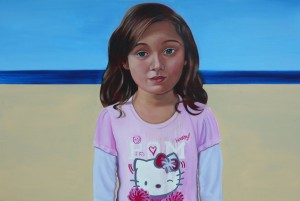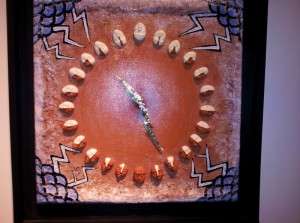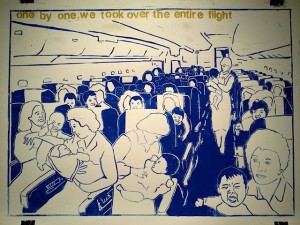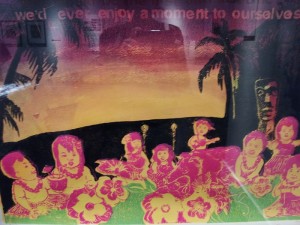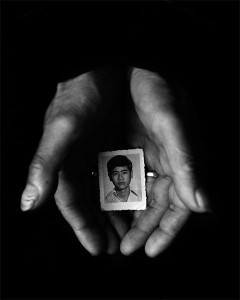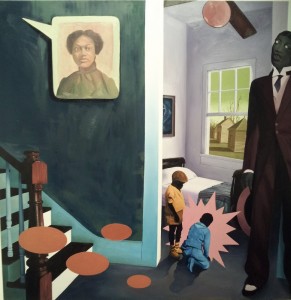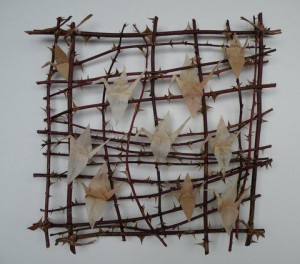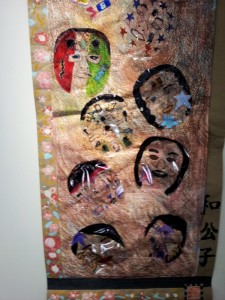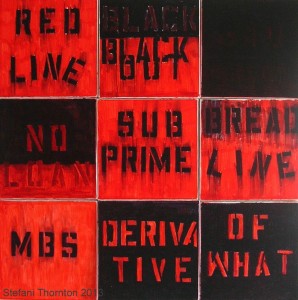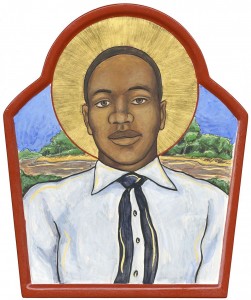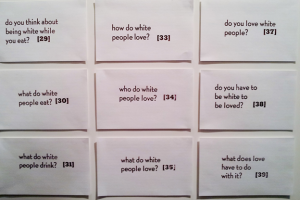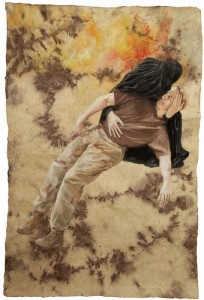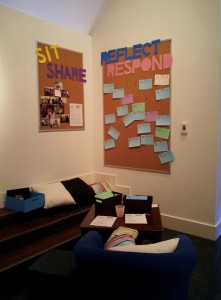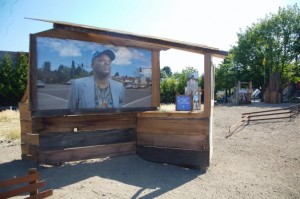Under my Skin Artists Explore Race in the 21st Century
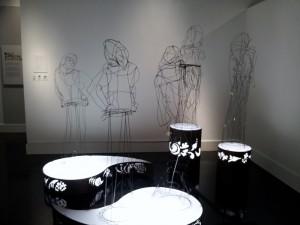
Mary Coss in collaboration with teenagers who wear hijabs. The wire sculptures are images of the girls, the work included their art work and their conversation about wearing hijabs
What a difference a decade makes. In 2004 the Wing Luke Museum held a pioneering exhibition about racism called “Beyond Talk: Redrawing Race.” It was catalyzed by the racism,particularly against Arabs, that burst into the open following the World Trade Center attacks,. It included 12 artists showing twenty artworks, with educational and interactive components for every work in the exhibition; each work also asked for our responses in a journal nearby. It also was an early example of an art exhibition with an internet component that teachers and the general public could access easily. It encouraged book clubs, discussion groups, library gatherings on race, and many other specific actions. Southern Poverty Law Center was a partner and the website included their program ” teaching tolerance.”
I analyze this exhibition in Chapter 5 “Exposing Racism” in my book Art and Politics Now, and compare it to the exhibition organized by Coco Fusco and Brian Wallis “Only Skin Deep: Changing Visions of the American Self.” I suggest there that the Wing Luke with its community based model was far more effective in penetrating the deep ignorance (among white people) about racism and how it operates. They moved beyond simply representing racist images, and into engaging the audience in their own perspectives.
Now the Wing Luke Museum returns tothe topic of racism with “Under My Skin, Artists Explore Race in the 21st Century.” The catalyst today seems to be exploding (or exploring) the myth of the “post racial” society, And of course, post race does not mean post prejudice. This exhibition is less interactive than the 2004 exhibition, but in some ways it is even more affecting, because of the intensity of the art works.
But it is not at all a reprise of the previous exhibition.
First of all there are twice as many artists, and consequently a larger range of topics and media. There is also less emphasis on the national and global political and cultural environment and more on personal experiences.
Another striking difference is the fact that two artists refer to loss of identity as a person of color, First there are the paintings by Laura Kina whose white-appearing daughter is the signature work of the exhibition. She represents the fifth generation in the artist’s family in which successive marriages altered skin colors.
A ceramic work by Native artist Erin Genia charts the dilution of racial color as though on a clock face with faces losing their color as you progress around the clock. Genia is refering to the blood quantum rule for racial membership in native tribes. The federal government declared that a native person must prove 25 per cent native blood with documentation. Obviously over time, fewer and fewer people will qualify.
A second and related theme, is cross cultural adoption or interracial families, as explored in the stunning prints by Darius Morrison, a young man adopted as a baby from Korea. He re imagines the flight of the babies from Korea even giving them a party in Hawaii a wonderfully creative approach.
The poignant photographs by Canh Nguyen suggest the emotional distance that occurs when someone is far from their cultural roots. His black and white photograhs include this work of his father’s hands, holding the only photograph of himself as a boy that survived his trip to the US after the Vietnam war. He raised three children a a single parent. Another artist Minh Carrico suggests the distortions that occurred in his childhood, raised by a Vietnamese mother and a white (Vietnam Vet) father in Arkansas: he digitally adds frightening masks on top of his childhood photographs.
Two artists appeared in both exhibitions: the wonderful painter Ronald Hall who frequently bases his work on intense moments in African American history. His painting has become more complex and layered in the ten years since the previous exhibition. The topics addressed confront us immediately, but then the horror of them sinks in. They really need no explanation.
Polly Purvis, a white artist who has been living with and documenting the Swinomish Tribal Community for ten years. Here she includes both photographs of a Powwow and its opposite, racist kitsch that stereotypes Indians.
There are other historical works, referring to the Japanese Internment, in the sculpture woven or rose branches by Fumi Matsumoto, and Kathy Budway’s video which combines historical footage from the Civil Rights movement and students in her ESL class who explode the popular media stereotypes of African Americans by studying outstanding African American historical figures.
Speaking of students, two other works were the result of working with children or young adults. Mary Coss encouraged Somali girls wearing hijabs to talk about their experiences ( see her wire sculpture portraits of the girls at the top of the blog) .
Kathleen McHugh invited children to identify themselves beyond skin color in a large collaborative drawing with a single tan color
So what else did we find in the exhibition? Real estate: red lining in confrontational paintings by Stefani Thronton.
urban violence in the icons by Jasmine Iona Brown.
Naima Lowe turns the tables on white people with her 39 questions for white people that consist of all the dumb questions people of color are asked.
Violence against women is the big topic in the work of Tatiana Garmendia, whom I have written about before here. Her installation also includes works from another series called Lamentation. These surprising images of a woman covered in black cradling the body of an American soldier suggest that mourning is a universal process that has nothing to do with race or culture. Everyone has the same feelings when someone dies.
Garmendia has a global perspective, although her opposition to violence against women is based in a personal experience: she witnessed it as a child in a Cuban prison shortly after the Communist revolution. She has carried a terrible memory of that with her and only now is able to refer to it in her work.
In looking at a show like this, the tendency is to stay outside of the issues represented, but actually, all of these works touch everyone. We are all part of a society that practices racism in so many ways, we are all perpetrators, whether consciously or unconsciously, we are all prejudiced. So the exhibition includes a discussion area that allows people to talk about racism and prejudice.
Near that comfortable place are large photographs that were displayed in the Central District in an empty lot by Inye Wokoma working in collaboration with Jenny Asarnow and NKO. The images present a few of the people who live nearby. They are large photographs, each person is dignified and self sufficient. Accompanying this work is a series of interviews with people talking about the neighborhood.
There is also an online facebook, youtube and audio as part of this project.
Conversation and familiarity is one key to ending prejudice and racism.
This exhibition was very personal, there was no reference to larger reasons for prejudice, like the “war on terror,” or our immigration policies, that are locking up thousands of people in detention and deporting them across our country. There was no reference to capitalism as a means of dividing people, creating terrible economic disparities and unequal access to education and a leading cause of urban and domestic violence; there was no reference to our enormous privatized prisons that are operated for profit by private companies ( as are the detention centers).
But personal as it was, the exhibition does offer a way forward: understanding experiences that are based on cultural difference, learning of the difficulties that people face because of their racial identity, helps to develop at least awareness. One on one dialogue is where we can start. It is those big generalities about terrorism and war and “the other” that create unconscious fear. Fear leads to a desire to protect ourselves, and that is the basis of prejudice and discrimination.
I feel fortunate that I grew up in New York City, where I was immersed in a great mix of people not only of different racial backgrounds, but also different economic backgrounds, religious backgrounds. It gave me a good preparation for understanding that we are all simply human beings.
Don’t miss this important exhibition, and plan to go more than once. Here is another review on the website of the Seattle Globalist. I haven’t seen any other press coverage.
This entry was posted on June 16, 2013 and is filed under Art and Politics Now, art criticism, Contemporary Art, Feminism, indians, Racism, Uncategorized.

